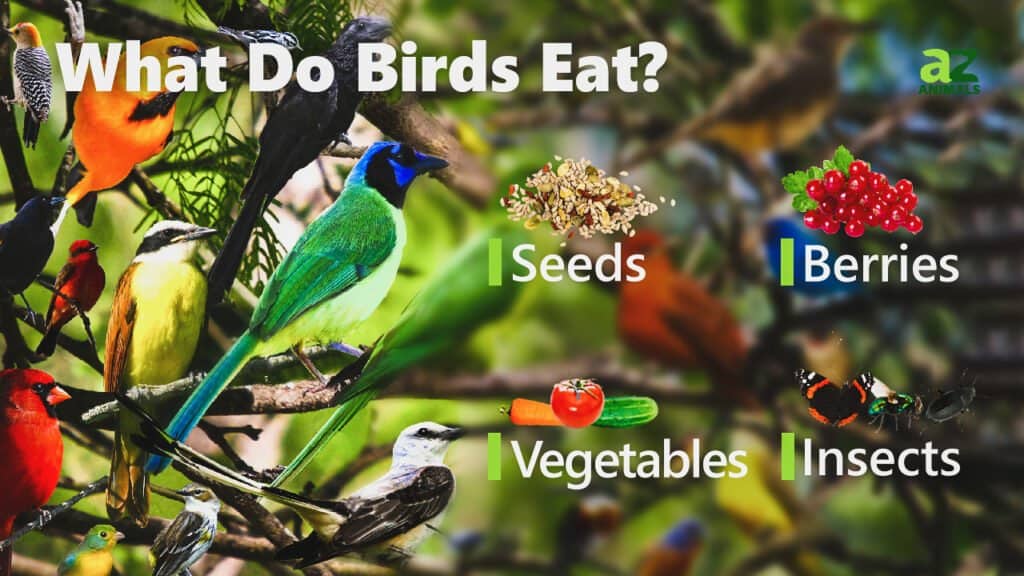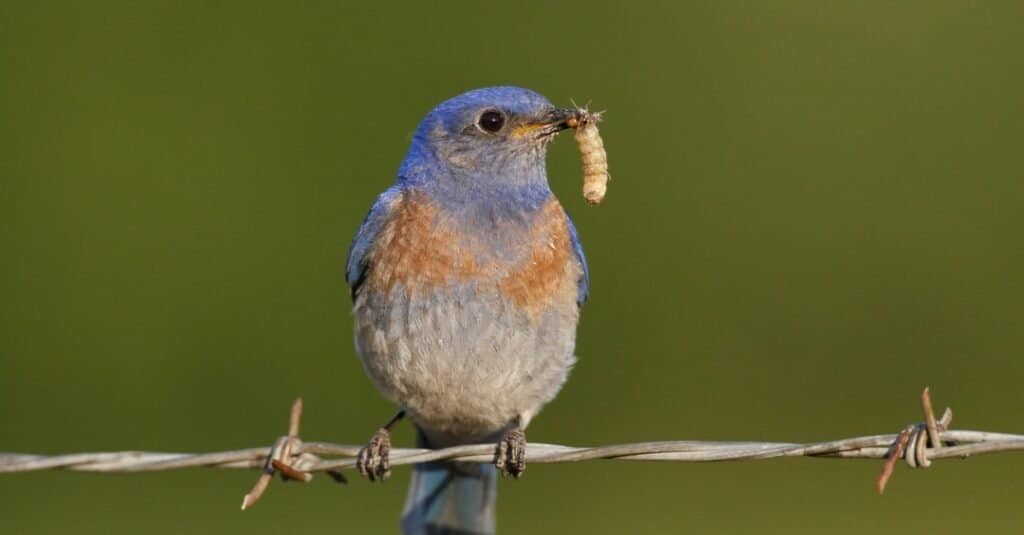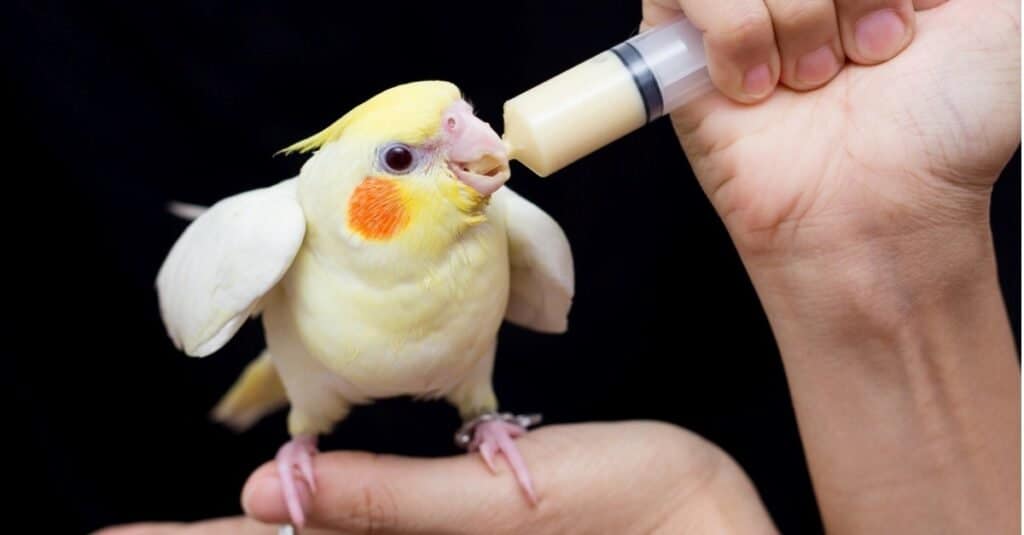Have you ever tried to make your own bird feeder? One of the most common ways of doing this is with a pinecone, peanut butter, and birdseed. Simply slather the pine cone in peanut butter, roll it in seeds, and hang it outside for your neighborhood birds to enjoy. These sorts of projects are a great way to attract birds to your backyard, but they won’t work for every bird. Birds are an extremely diverse group, with more than 11,000 recognized species worldwide. They live in different climates and evolved unique adaptations to help them survive in harsh habitats. While some birds live on a diet of a select few foods, others will eat just about anything. Given these variances, it’s impossible to know for certain what foods one bird eats just by examining its features and environment. Which begs the question, “what do birds eat?”
In this article, we’ll attempt to answer this broad question by identifying foods most birds like to eat. From there, we’ll discuss how birds hunt and forage for good. Next, we’ll compare what birds eat in the wild versus what pet birds eat. Finally, we’ll end with a brief talk about the diets of baby birds. So, get ready to do some bird watching, as we set out to explore the answer to “what do birds eat?”
What Do Birds Like to Eat?

The foods that birds eat are as diverse as the birds themselves. Some birds, such as insectivorous birds, eat a diet made up primarily of insects. On the other hand, some birds are mostly herbivorous, meaning they eat mostly plants. That said, herbivores are a large category. Some birds are frugivores, which means they predominantly eat fruit, while others are granivorous birds that eat mostly seeds. Still, others are carnivores that eat a diet made up of live prey. Given this variety, it’s imprecise to say that certain foods are liked by all birds. Rather, some birds like to eat certain foods, while others prefer different fare. If we took the time to list out all the foods the birds like to eat this would be a very long article. So instead we’ll focus on 15 of the foods that are commonly eaten by birds. They are as follows:
- Grasses
- Vegetables
- Worms
- Insects
- Bugs
- Grains
- Fruits
- Eggs
- Nectar
- Seeds
- Nuts
- Small mammals
- Fish
- Small reptiles
- Small amphibians
How Do Birds Hunt and Forage For Food?

Eagles possess incredible sight and can see clearly at far distances nearly 8 times better than humans.
©FloridaStock/Shutterstock.com
Like humans, birds can see, hear, touch, taste, and smell, although in varying degrees depending on the species. That said, sight is by far a bird’s most important sense. Not only can they see in color, but some can also see shades in the ultraviolet spectrum. Some birds, such as owls, possess eyes that are well adapted to seeing at night. Others, such as eagles, can see clearly at far distances nearly 8 times as well as humans. As for hearing, while birds don’t appear to have ears, in truth they hear exceptionally well. Pigeons can hear extremely low-frequency sounds and can detect sounds from far away including storms and earthquakes. Although most birds don’t rely on smell, some have developed excellent olfactory senses. For example, vultures can smell carrion from up to a mile away.
Depending on the species and its diet, birds use a variety of different tactics to hunt and forage for food. Some birds, such as falcons, rely on speed to catch their prey. A falcon soars through the sky until it spots its target, and then descends in a quick swooping dive to catch its prey before it can escape. Others, such as purple martins, engage in aerial acrobatics to catch flying insects in midair. On the other hand, some birds spend more time foraging for food than hunting. For example, parrots spend most of their time in trees foraging for fruits, nuts, and seeds. Meanwhile, geese and ducks forage on the ground or in ponds for grasses, weeds, and seeds. Still others, such as penguins, will dive under the water to hunt for fish, only surfacing once they’ve caught their fill.
What Do Birds Eat in the Wild?

Bluebirds eat mostly insects in summer, and berries in winter.
©iStock.com/mooninwell
Generally speaking, birds in the wild eat foods such as insects, plants, berries, fruits, nuts, and seeds. However, their diets can vary wildly depending on the species and their environment. In addition, wild birds will normally eat different foods throughout the seasons as the weather changes. For example, bluebirds eat mostly insects such as grasshoppers, worms, ants, and spiders in the summer. However, in winter their diet changes and they eat mostly fruits and berries. Meanwhile, seed-eating birds such as finches will eat seeds like sunflowers all year-round, when available. Similarly, the diets of carnivorous birds tend to stay fairly stable all year round, changing only depending on migration habits. Bald eagles mostly eat fish, but will also scavenge for trash or eat small mammals, reptiles, amphibians, or carrion. Given this variance, it’s important to know what wild birds eat throughout the year to accurately handle conservation efforts.
What Do Birds Eat as Pets?

Pet birds eat mostly seeds, nuts, fruits, vegetables, and pellet food.
©iStock.com/averess
You may not know this, but birds can be very picky eaters. As such, it’s important to feed your pet bird a balanced diet to make sure it stays healthy. Generally speaking, most species of pet birds are omnivorous or herbivorous, so we’ll exclude carnivorous birds from this discussion. We’ll focus our discussion on popular pet species such as parakeets, finches, cockatiels, and parrots. Contrary to popular belief, your pet bird cannot just live on birdseed. While limited amounts of birdseed is alright, many commercial brands are also very high in fat. This can lead to your bird gaining too much weight, which can cause health complications. Overall, it’s safe to feed your bird foods such as:
- Seeds (unsalted and raw)
- Nuts (unsalted and raw)
- Fruit
- Berries
- Insects
- Mealworms
- Vegetables
Safe vegetables include things like bell peppers, squash, carrots, and sweet potatoes. While all these foods are safe in limited quantities, many bird owners choose to feed their pets a predominantly pellet-based diet. Pellet food is easy to eat, stores for a long time, and provides most of the nutrition birds need. That said, it’s certainly fine to feed a whole food diet to your bird, so long as everything is in balance. However, there are certain foods you should not feed your pet bird, including:
- Chocolate
- Meat
- Fruit pits or large seeds
- Dairy
- Alcohol
- Avocado
What Do Baby Birds Eat?

Baby birds eat the same things as adults, but require extra attention if raised away from their parents.
©iStock.com/tatchai
Like adult birds, the nutritional requirements of baby birds vary depending on the species. In the wild, baby birds eat the same things that their parents eat. That said, there are a few notable distinctions. Shortly after birth, baby birds, or chicks, are completely reliant on their parents for nutrition. They require plenty of protein, so their diet is initially heavy in foods like insects and worms. However, they may also eat seeds, nuts, and berries. If you encounter an abandoned baby bird, you should first try to contact a rescue organization. Otherwise, you could attempt to feed the bird puppy kibble soaked in water. Ground-up worms are also an excellent choice if you can get them. Always consult with a vet if you are raising a baby bird to make sure it’s getting the right balance of food.
The photo featured at the top of this post is © iStock.com/hannurama
Thank you for reading! Have some feedback for us? Contact the AZ Animals editorial team.






